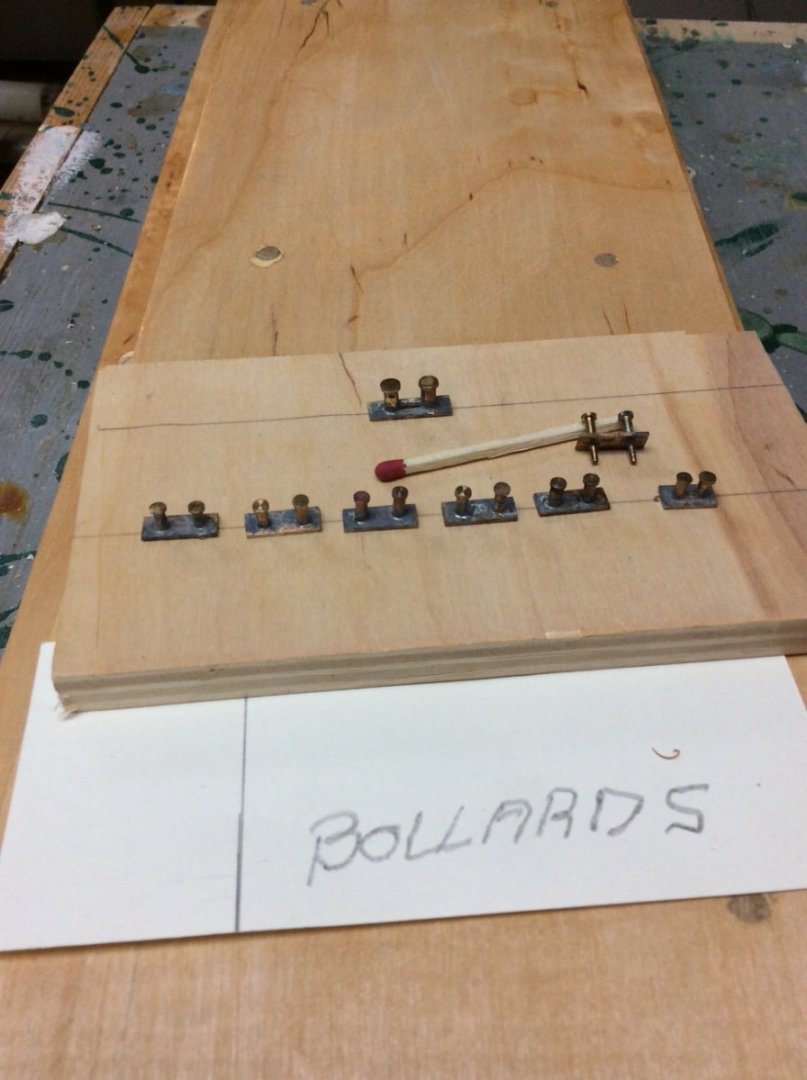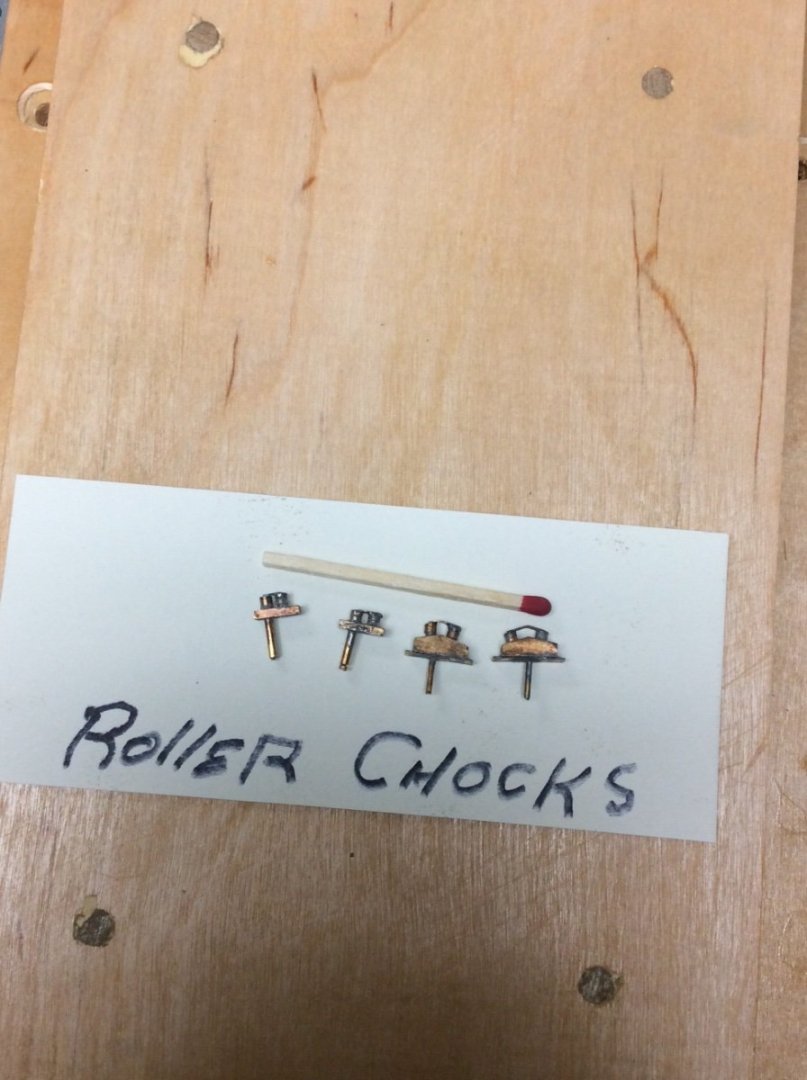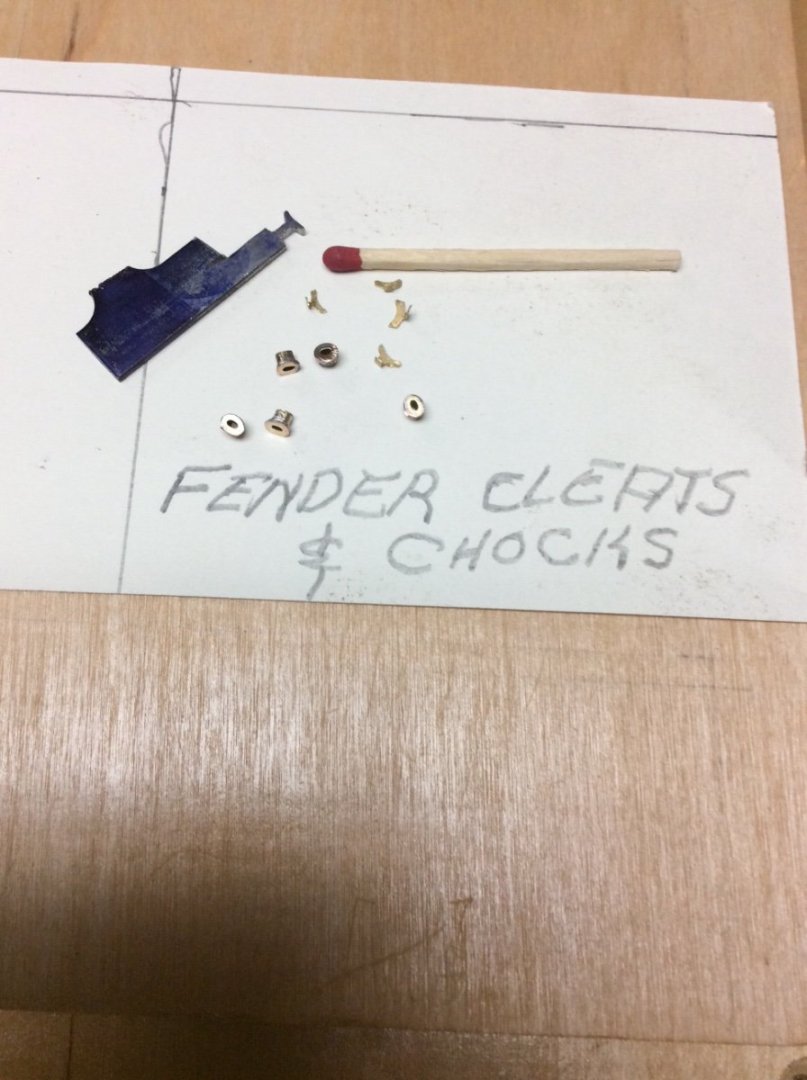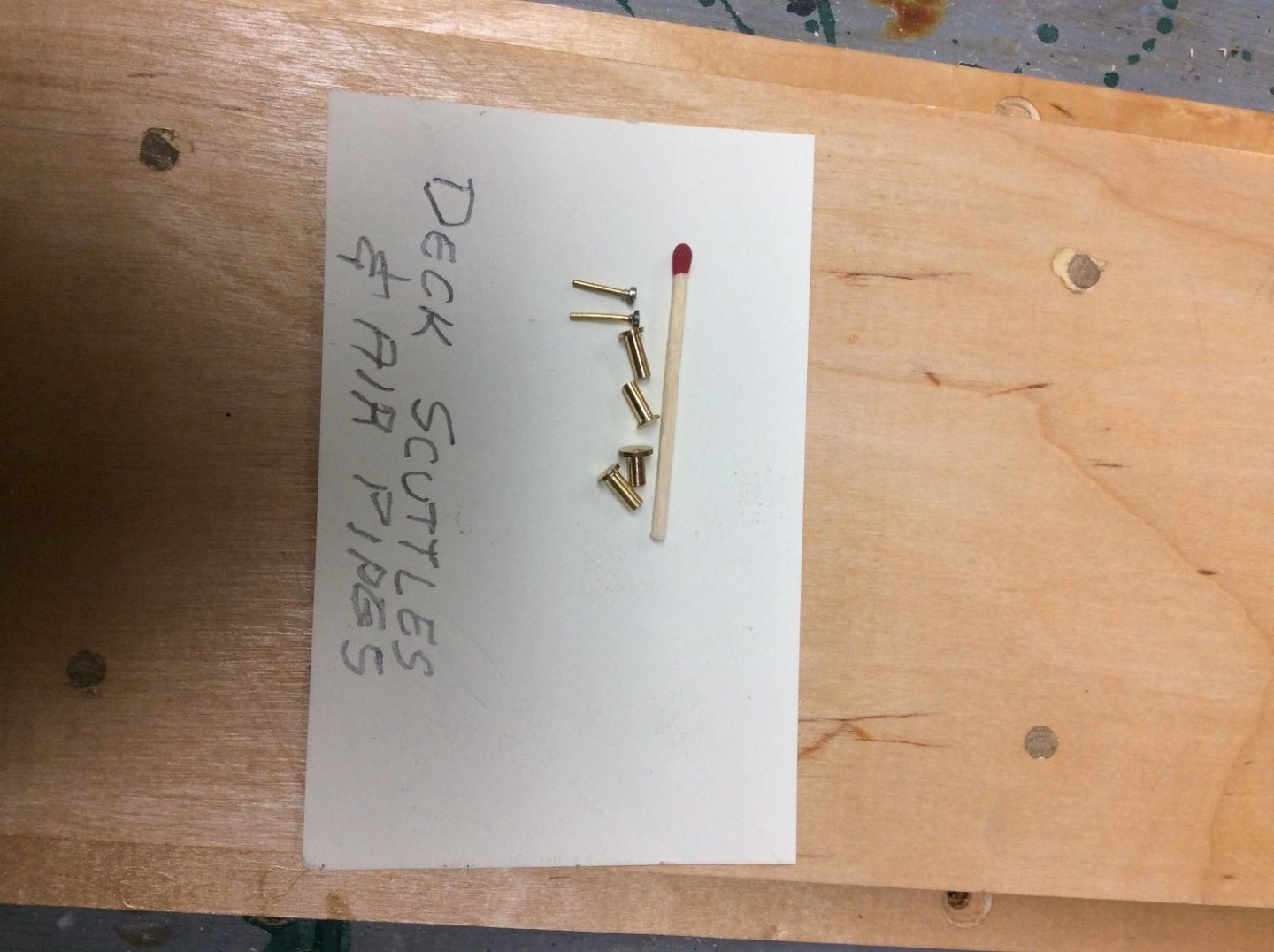
Roger Pellett
-
Posts
4,519 -
Joined
-
Last visited
Content Type
Profiles
Forums
Gallery
Events
Posts posted by Roger Pellett
-
-
At the risk of committing heresy! Why not omit the ratlines from the topgallant shrouds? I believe that I have seen drawings of Carracks where a Jacobs ladder ran up the backside of the mast.
Roger
- mtaylor and Keith Black
-
 2
2
-
Thanks Keith!
These simple pieces gave me a chance to work on my limited machining skills in anticipation of more difficult projects down the road; 6 steam deck winches and 1 capstan.
I dropped several parts while making them but was able to retrieve all of them. If I need more cleats, I still have my filing jig!
Roger
-
Beautiful Work!
That mainsheet looks like a real cat’s cradle!
Roger
- mtaylor, Retired guy, Keith Black and 1 other
-
 4
4
-
I spent most of my career in two businesses fabricating piping assemblies for high pressure steam service. Once erected in the field this piping fed high pressure steam to turbines. As scale from heat treating could damage turbine blades, customer specifications required that the inside surfaces of the pipe be blast cleaned with abrasive grit. The ends were then capped with steel end protectors sealed with duct tape. These piping sub assemblies might be stored in the field for several months waiting to be erected.
To minimize cleaning of rust after erection customers began to require bags of silica gel to be taped to the inside of the end protectors. Business conditions sometimes delayed construction causing the silica gel to degrade. ZRust solved the problem. When I found some rust on tools stored in my basement workshop I found ZRust available on Amazon.
Roger
- mtaylor, John Murray and Canute
-
 3
3
-
Assuming that this is a warship, would paddling provide enough momentum for the ram to be effective?
Roger
-
-
As a minimum you need to do something to protect those valuable power tools. I would suggest storing them in a plastic tub with a snap on lid. You then need to do something to control the environment within the tub. A couple of ideas:
Silica gel desiccant- This can be effective but it works by absorbing moisture. It must be changed regularly. If you neglect to regularly change it, it will become saturated with moisture; a gooey mess.
Z Rust- This is a plastic strip impregnated with volatile hydrocarbons that vaporize to leave a very thin film on metal surfaces within an enclosed space. The film is so thin that you won’t know that it is there. I keep strips of this in cabinets storing tools in my workshop. A better choice.
Roger
-
A short update.
Since my my last post I have been working to complete the poop deck/ after bulkhead assembly. I will post pictures of this in the near future. Meanwhile, I have also been making the small fittings that will adorn this deck. When doing so I have been making all of the fittings for a given type for the whole ship. It is easier to make these in batches than one off as needed. All were made from brass turned or milled on my Sherline. Small base plates were cut from brass on my Byrnes Saw. The mini sled that I made and posted elsewhere allowed me to cut very small pieces safely without the saw ejecting them into the unknown. The tiny cleats were made with the filing guide pictured. This was cut from scrap steel. All parts will eventually be painted. There will be no bright brass on the model except for the propeller blades. The copper color is a result of pickling the soldered parts in Sparex.
Roger
- Keith Black, FriedClams, mtaylor and 11 others
-
 14
14
-
Bayeaux, a handsome city not damaged in the fighting. The Tapestry Museum is well worth a visit.
Roger
- king derelict, lmagna, Canute and 2 others
-
 5
5
-
The overall effort to land a man on the moon was of course an engineering effort of the first order as was the Polaris submarine program, high performance jet aircraft, etc. Computers were important tools for the success of of these, and the people who programmed them were important members of the team.
I’m sorry but I don’t agree that designing the next cell phone AP measures up as an engineering accomplishment.
Roger
-
The old Stanley Steamers were “cool” but they were an engineering dead end. Steam plants require skilled operators. Control of feedwater is a particular problem. For automobiles and trucks to appeal to the mass market they needed to be simple enough to be operated by those lacking an understanding of mechanical engineering. The internal combustion engine proved to be something that could be operated by almost anyone.
IMHO, much of the “high tech” stuff is not real engineering. Building bridges, ships, airplanes, power station, etc requires a broad balance of theoretical and hands on experience. Sitting in a cubicle coding a computer does not compare with this.
Roger
-
Since we don’t know where you live, your workshop situation, etc., this assumes that you are a “kitchen table” modeler living in the USA living within a reasonable distance from a shopping center.
Go to your nearest craft, hobby, or home Improvement store and buy basswood sheet or wide strip material. Using whatever glue you have to build the model glue the basswood to the damaged beam. Roughly cut the repaired beam to shale with a craft knife. Using a block of wood as a backup sand to finished shape.
Yellow PVA (Elmer’s, Titebond, etc) is preferred for gluing wood.
Roger
-
-
Hopefully those 100’s of flanged brass portholes in the bag shown above are not going to find their way into your finished model. In real steel hulled ships the portholes are cut into the shell plating. The cast brass/bronze frame that holds the glass is fastened to the inside of the hull so is not visible from the outside.
Roger
- king derelict and Canute
-
 2
2
-
At least in the US Navy, the realities of combat put an end to on board luxuries. I recently read that when new ships arrived in the Pacific Theatre, crews were even put to work removing paint from all interior spaces. Interior paint was considered to be a contributing factor in the September 1942 loss of the aircraft carrier USS Wasp. Thrown into the Guadalcanal Campaign before her crew had time to completely strip her for combat, painted surfaces helped spread fire throughout the ship.
I wonder how much of this had been done to the Italian Cruisers when they were lost at Cape Matapan.
Roger
- popeye the sailor, mtaylor, Canute and 2 others
-
 5
5
-
Up here on the Great Lakes most ports are tiny as they are located at the mouths of small rivers that drain relatively flat landscapes. Prior to adoption of bow thrusters two techniques were used for turning long ships in confined spaces.
The first was pivoting on a dropped anchor. The SS Badger built in c1950 as a cross lake railroad car ferry now carries passengers and their cars across Lake Michigan. Upon arrival at Ludington, Michigan she was still using this technique in 2007, the last time that we crossed the lake aboard her.
The second was “winding.” To include the most volume and displacement into hulls of restricted dimensions, Great Lakes bulk carriers were built with plumb bows. In ports with improved harbors the vessel could be turned by pressing the bow against the side wall, putting the rudder hard over and using the thrust against the rudder from the screw to kick the stern around.
Today, all active Great Lakes cargo vessels are fitted with bow and often stern thrusters.
Roger
- mtaylor, lmagna and GrandpaPhil
-
 3
3
-
Very nice work Valeriy. Warship boats are a particular interest of mine. I also liked the soldered brass frame; a great way to keep from losing the hull shape when shaping the intermediate wooden filler blocks.
Good to hear that you are safe and well.
Roger
-
-
I suspect that the model in the pictures was built by Eric Ronnberg. Way back in the late 1970’s he wrote an article in the Nautical Research Journal about coppering ship models. The article includes photos of several coppered ships including whalers. The article discusses the “mottled effect” that interests you. I vaguely remember that he produced it by heating and quenching the individual sheathing pieces.
You should be able to be order an inexpensive reprint of the article from the NRG office. Look for it on the article search function on the NRG website.
Roger
-
Many of the natural gas power plants that are replacing coal are Combined Cycle plants that use the very hot exhaust from gas turbines to generate steam in waste heat boilers to power steam turbines. By generating electricity from both the high temperature gas turbine and the lower temperature steam cycle these plants offer very high thermal efficiency.
Here in the US a number of coal fired plants have been converted to gas powered combined cycle plants. The coal fired boiler is demolished and replaced with gas turbine/ waste heat boilers. Much of the existing steam cycle piping and equipment is then used for the new plant.
Roger
- Ian_Grant, Egilman, Rik Thistle and 4 others
-
 7
7
-
I understand that bearing (or shaft?) surfaces were often coated with Prussian Blue. When assembled and the shaft rotated the mechanic could see high and low spots. The bearing was then scraped with a bearing scraper to improve the fit.
Steamships with reciprocating machinery required Crewmen called Oilers. Oilers would make the rounds and feel bearings; with the engines running! A good Oiler could find a “hot bearing” that needed lubrication by feel.
Roger
- Egilman, Canute, thibaultron and 3 others
-
 6
6
-
Rik,
You probably already know this but the power produced by a reciprocating engine is proportional to PLAN where:
N= RPM
A= Piston Area
L= Piston Stroke
P= Mean Effective Pressure
L was limited by the depth of the ship’s hull and these large side paddlewheels were limited by how fast they could turn. In early days boiler and piping design, and feedwater control problems limited operating pressure. In the 1800’s the huge loss of life from boiler explosions resulted in the writing and establishment of the ASME Boiler design code.
The one variable that was not restricted was A, piston area, resulting in large diameters.
Roger
-
Wonderful! Thanks for posting. Lining everything up to be square and concentric while being stable enough to withstand loads from machining is expertise that few people have. Seeing work like this people often say, “Wow, you’re good with your hands.” They fail to understand the mental challenges involved. This is first class workmanship.
Beam engines were used extensively here here in the USA for marine propulsion, particularly for passenger steamers on the Great Lakes, Eastern Rivers, and The East Coast. These very large slow speed engines turned side paddle wheels. Most used low pressure steam, less than 50psi, getting much of their motive power from the condenser vacuum. His meant huge size; cylinder diameters of 6ft were not uncommon.
Roger
-
Beautiful job!
Elsewhere on the forum there is a discussion about WW II Japanese planes using western letters and Arabic Numerals for markings. It looks like the Israelis use both Hebrew and western markings.
What is the significance of the lathe letter V seen on Israeli military vehicles?
Roger
- Egilman, Edwardkenway, mtaylor and 4 others
-
 7
7







Cap San Diego by mikegr - 1/160
in - Build logs for subjects built 1901 - Present Day
Posted
I would start by making a former from a solid piece of wood- lumberyard pine. I would build the aft bulwarks over the former; with the former upside down. I would incorporate a very thin deck for rigidity. I had a similar problem with my Benjamin Noble (posts below). I used sheet brass. You could mold this with ultra light fiberglass. The molded assembly, removed from the former is then glued to the model.
Roger